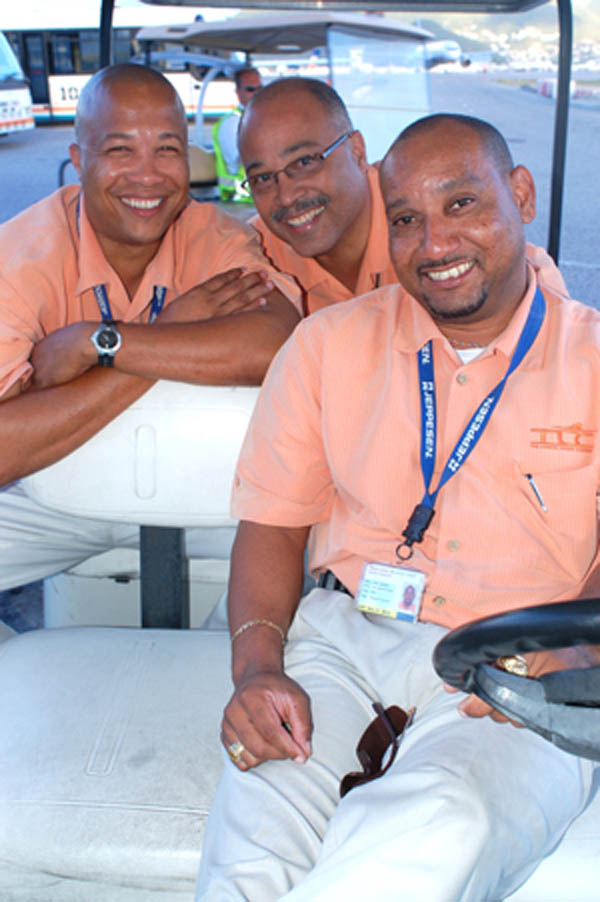 AIRPORT:--- A delegation of TLC-Aviation will go to an aviation conference to promote St. Maarten and aims to attract more and new visitors. This time the meeting is held in Teterboro, in the New York vicinity. Promotion of airport activities of any kind aims to have a positive impact on St.Maarten’s economy. Steven Kong, the Managing Director of TLC Aviation points out that there is an urgent need for more aircraft parking area at our airport to meet the needs of additional aviation traffic.
AIRPORT:--- A delegation of TLC-Aviation will go to an aviation conference to promote St. Maarten and aims to attract more and new visitors. This time the meeting is held in Teterboro, in the New York vicinity. Promotion of airport activities of any kind aims to have a positive impact on St.Maarten’s economy. Steven Kong, the Managing Director of TLC Aviation points out that there is an urgent need for more aircraft parking area at our airport to meet the needs of additional aviation traffic.
“The meeting in New York is important because the East Coast of the United States bring us traffic, especially around the period that they call ‘Spring Break’; usually in March. It is the third out of four conferences that we are attending this year. We spend a significant dollar amount this year alone trying to attract clients from abroad. We do all our promotional work that benefits St.Maarten without the support from any hotel, tourist or government organization. We are trying hard to bring in new clients. A problem that we are facing though, is insufficient parking space when the aircraft are actually coming.”
Especially during the peak season it creates a significant problem. Several trip planning companies abroad are urging the aircraft operators and owners to make early arrangements. In their communication with their clients, they try to make them aware of St.Maarten’s problem.
“Look at it from their perspective,” Steven explains. “They plan early and have to make reservations for high cost hotels far in advance. It also means making deposits accordingly with the reservation. Once they arrive in St.Maarten airspace, they may experience a congestion at the airport because of high air traffic or the ramp being filled with commercial airliners. So, they are either put in a hold pattern and have to circle around in the sky, or they have to fly to their alternate airport.”
Prior to the departure abroad pilots or flight dispatchers have to file a flight plan. Part of required flight planning involves the identification of one or more airports which can be flown to in case of unexpected conditions at the destination airport. Alternate airports are the ones that can be reached with the anticipated fuel load. Circling too long may create a fuel problem and the decision will be made early to fly elsewhere.
“If the aircraft is getting into a situation that it will have to fly to the alternate airport which may be St.Kitts or Antigua, they lose the high hotel deposits that were paid in advance, not to mention the inconvenience,” Steven explains. “So, what will happen next time? They may not plan on SXM in the first place, but rather immediately plan to fly elsewhere. And the word spreads among pilots and dispatchers at international conferences. It is not the just the aircraft and hotel business that we are losing. Mind that the aircraft crew on average stays seven to fourteen days in a luxury hotel. The aircraft owners are often yacht owners and they may decide to have their yacht and arrive where there is an airport with less congestion. Once that decision is made, they may not come back the next time. Trying to attract new clients is an expensive undertaking, but trying to get a lost one back, is more costly. It is not just a matter of lost business but also a lost reputation.”
Aviation activities contribute directly to employment and the general economy. It is called ‘Economic
Impact’. The three major components of economic impact are direct, indirect and induced impacts. Direct economic impact measures the employment directly associated with the aviation activities on the airport and includes private aircraft handling and other support staff. Indirect impacts include employment in businesses that supply or provide services to the aviation activities. Induced employment is employment created because of expenditures by individuals employed both directly and indirectly by businesses directly related to aviation activity on St.Maarten. Economic impact ads together the direct, indirect, and induced impacts. It should not be underestimated.
“TLC-Aviation, is a wholly owned St.Maarten company that means all our revenues stay in St.Maarten,” says Steven Kong. “We don’t pay franchise fees to a company abroad for instance. You might say that all we do is by St.Maarteners for St.Maarten. We employ fourteen people who have their families; they pay rent, buy food, etc. When we are bringing in new clients, it also means additional business for hotels, car rentals, and yes, for whatever yacht owners may spend here from supplies to harbor fees. Crews enjoy parking at our airport, for one because of the ease of Government formalities. In case of mechanical aircraft problems SXM has the advantage over other airports that the needed parts are brought in import tax free. But also mechanics have to be flown in who have to stay somewhere. They all like accommodations here; the restaurants, beaches, casinos, night clubs. There is something for every crew to enjoy. Every crew would rather stay in St.Maarten for all these reasons mentioned. It is our goal to promote that at conferences and provide it here. Yet, we have to find a solution for aircraft parking needs. The reason that we are traveling to these conventions is to attract additional business. So when the time comes and a request comes in for parking, TLC-Aviation needs to comply based on promises we have made at those conferences.”











